Central & South America
[Contemporary]
Central and South America encompasses a vast and diverse area of the world, with many complex and stratified societies. Their rich musical heritage is the product of many influences, including indigenous (Pre-Columbian) cultures, European colonial cultures, the cultures of Africa, along with the cultures of immigrants from the Middle East and Asia. This diversity has had a profound influence on religion and politics and has richly contributed to the musical heritage of the contemporary Central and South America regions.
Vessel Flutes
Vessel flutes are a type of flute with more of a spherical hollow body, rather than a straight tube-shaped body. The far end of the vessel is also closed. There are several types of whistles and vessel flutes made of clay, found in the cultures of Central and South America, including ocarinas, whistles, and water flutes.
Ocarinas - Whistles - Flutes
The ocarina is a wind instrument (aerophone) with enclosed space, finger holes and often a projected fipple-type mouthpiece. A fipple mouthpiece is an opening with a channel/duct that directs the air to pass through to a sharp edge that splits the air into and outside the instrument, like a recorder. Other ocarinas may rely on the player’s lips to direct the air against the edge, like a transverse or end-blown flute, which are called edge-blown flutes. According to legend, Hernán Cortes brought a group of Aztec dancers and musicians to Charles V, Ruler of both the Holy Roman Empire and the Spanish Empire, to perform at the royal court, and it was here the idea of the ocarina evolved in Western Europe.
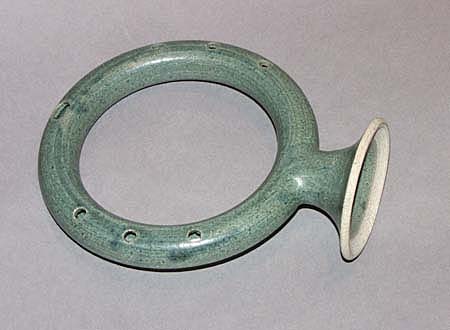
Ring Flute
Moche Culture
Peru
Polychrome clay
ca. 1900s
A rare circular clay ring flute (replica), sometimes identified as a “head ring,” as it mimics certain Moche headdresses. It has an embouchure hole to blow on one side and six finger-holes. It terminates at the end with a flared bell.
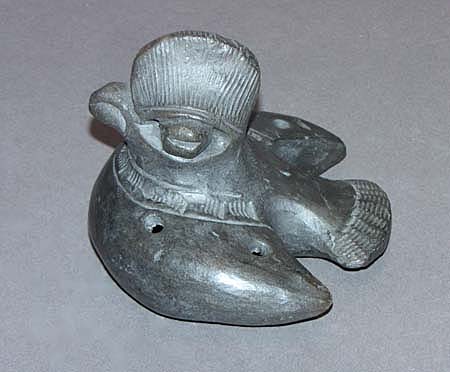
‘Avian’ (Bird) Ocarina
Tairona (Tayrona) culture
Columbia
Black ware Pottery
ca. 1970s
Ocarinas like this one are zoomorphic (animal shaped), however, they are still a mystery to us. Much research is still needed before a better understanding about these Mesoamerican (reproduced) musical instruments can be gained.
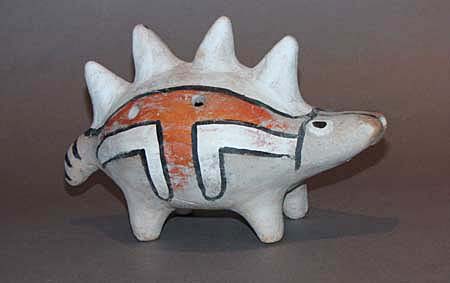
Porcupine Ocarina
Veracruz Culture (possibly)
Central Mexico
Terracotta, pigment
ca. 1970s
The Mexican tree porcupine, sometimes called the hairy dwarf porcupine is native to Mesoamerica, found from Panama to central Mexico. Their limbs and feet are modified for grasping as they live most of their lives in trees.
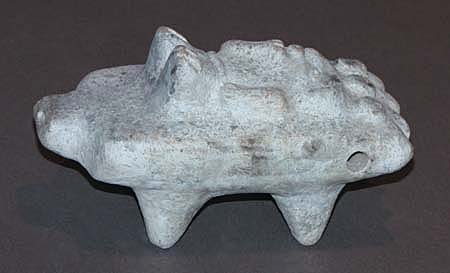
Funeral Effigy Ocarina
Aztec Culture
Mexico
Terracotta, pigment
ca. 1980s
From the Aztec regions of Mexico to the Mayan territories of what is today the Gulf region of Central America, ocarinas were and still are a part of the “toolkits” of shamans, used to communicate with the deceased and supernatural.

Toltec Whistle Flute
Toltec Culture
United Mexican States
Terracotta, pigment
ca. 1950s
A whistle flute with two roles of finger holes. At the front of the duct mouthpiece is the supernatural deity known as Quetzalcoatl, with a large, feathered head dress. Quetzalcoatl is known as the inventor of the calendar and the giver of corn (maize) to mankind.
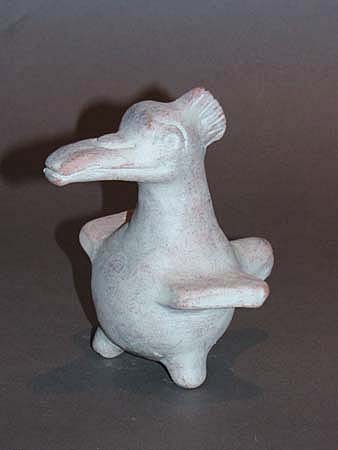
‘Avian’ (Bird) Ocarina
Veracruz Culture
Mexico
Terracotta, pigment
ca. 1980s
Ocarinas like this one would have been played possibly to mimic the sound of birds singing. The word ocarina means “little goose.”
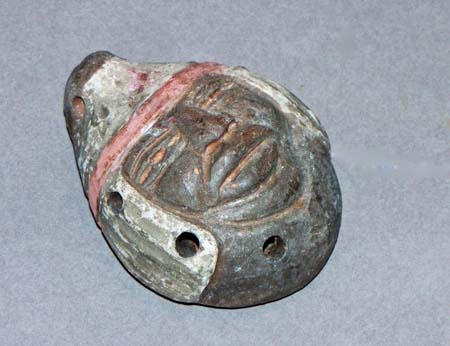
Andean Face Ocarina
Peruvian Culture
Andes Mountains
Terracotta, pigment
ca. 1950s
This Andean clay face ocarina shows a ‘cachucha’ (cap) on the top of the head that serves as the mouthpiece.
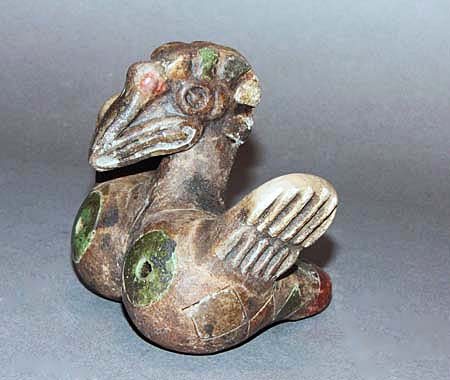
‘Avian’ (Bird) Ocarina
Maya Culture
Northwester Part of the isthmus of Central America
Terracotta, pigment
ca. 1960s
The use of clay in agricultural societies had important implications as most of their instruments were carefully and symbolically made from it. The mouthpiece on this two-hole ocarina is part of the bird’s tail.
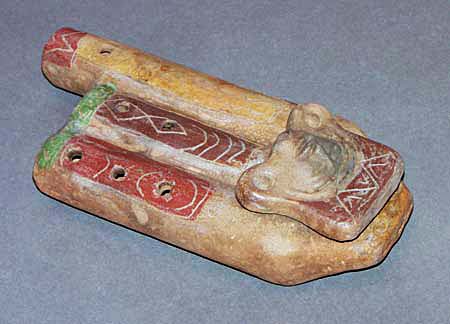
‘Three-Pipe Whistle’
Maya Culture
Jaina Island
Terracotta, pigment
ca. 1980s
A three-pipe flute with finger holes in two of the pipes, while the longest pipe serves as a drone. Attached to the pipes is possibly the face of a shaman.
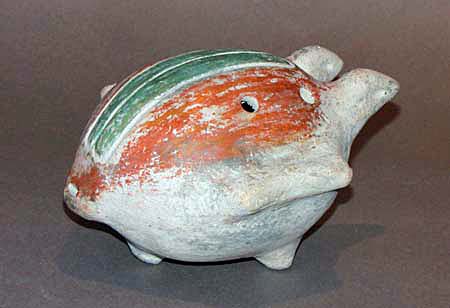
Globular Ocarina
Yucatec Maya Culture
Mexico’s Yucatán Peninsula, northern Belize and northeastern Guatemala
Terracotta
ca. 1970s
A ceramic vessel with four finger holes in the form of a globular creature with two heads and short fin-like wings. Opposite the double heads is the mouthpiece.
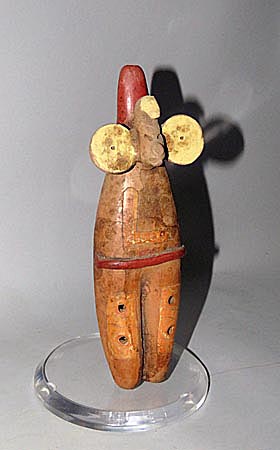
Figural Ocarina
Maya Culture
Jaina Island
Terracotta, pigment
ca. 1970s
Ocarina with four finger holes in sets of two on each of the figure’s legs. The blowhole is extending behind the figure’s head and painted red. Large protruding ear rings with matching forehead regalia. Collected by Dr. Doris Trojcak in the 1970s.
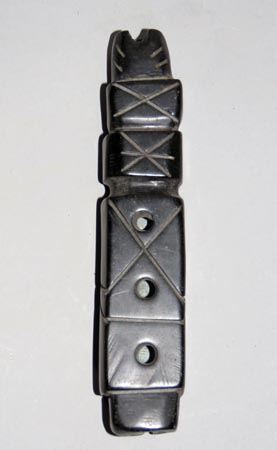
Tarka Flute
Andean Culture
Bolivia and Peru Sierra Region
Black ware pottery
ca. 1970s
The tarka is a unique flute of the Andes usually made from natural wood. It features a whistle-type mouthpiece with a small air hole. The Mesoamerican tarka was used in tribal ceremonies to mimic bird sounds.

‘Pottery Flutes’
Oaxaca Culture
Mexico
Black ware pottery
ca. Early 1900s
The town of San Ildefonso Salinas is in Guadalupe de Ramírez – in the State of Oaxaca. Oaxaca is one of the most culturally diverse in all Mexico; it also has one of the richest repositories of historic pipe organs in the New World.

‘Pottery Bird’ Flute
Toucan Species
Costa Rica
Pottery, pigment
ca. 2000s
This pottery effigy bird whistle represents the most recognizable of the toucan species of birds in Costa Rica, the keel-billed with it’s distinguishable over-sized beak. [Tourist Item – Souvenir]
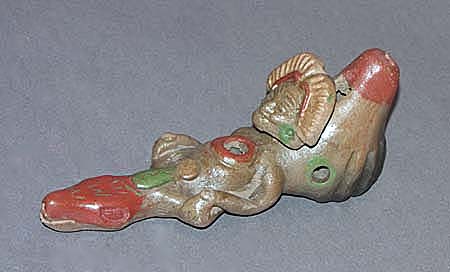
‘Shaman Whistle’
Maya Culture
Jaina Island
Terracotta, pigment
ca. 1980s
The crocodile is symbolic of wisdom and efficiency and is often the subject of mythology and folklore in this region. Shown here is a shaman riding a crocodile. [Tourist Item – Souvenir]
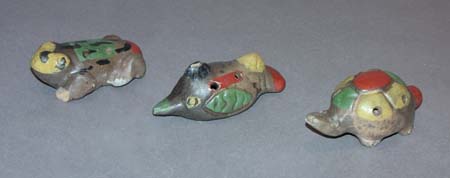
Zoomorphic Ocarinas
Aztec Culture
Mexico
Terracotta, pigment
ca. 1980s
Collection of small ocarinas – frog, fish, turtle, collected at Teotihuacan [pyramid]. Sold to tourists as souvenir.
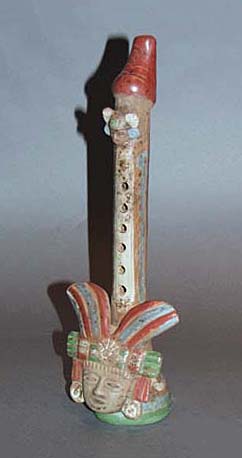
Tubular Whistle Flute
Aztec Culture
Mexico
Terracotta, pigment
ca. 1980s
A whistle flute adorned with a shaman’s head on the bell. [Tourist Item – Souvenir]

‘Jaguar Whistle’
Toltec Culture
Mexico
Terracotta, pigment
ca. 2010
The jaguar was considered a spirit companion associated with the Mesoamerican shaman. {Tourist trade – Souvenir)
Water Flutes
To produce music or sound with a water flute, it utilizes the principle that fluid/water that is in the back chamber is tilted to move the fluid/water to the front chamber, displacing the air in the front chamber which is then forced to move up and across the sounding edge of the open hole (mouth) at the top of the front chamber. These water flutes, were often made to serve as mourning flutes.
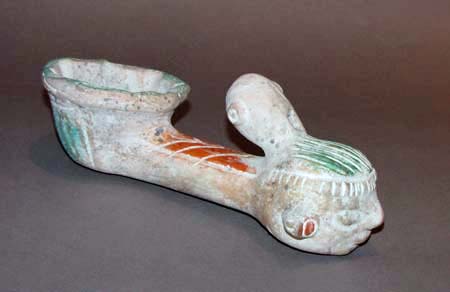
“Vaso Silbador Lloron” (weeping cup) Water Ocarina
Yucatec Maya Culture
Mexico’s Yucatán Peninsula, northern Belize and northeastern Guatemala
Terracotta
ca. 1970s
The Yucatec Maya cosmology is typically Christian figures commonly identified with Mayan deities. Public religion is basically Christian, with masses and saint’s day celebrations. The native pre-Columbian religion is observed in domestic rites.
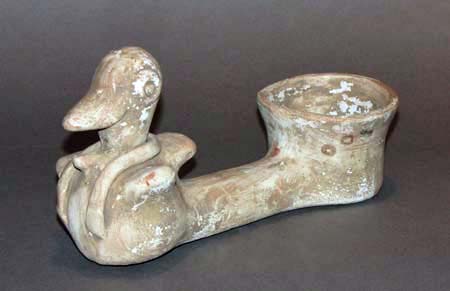
Bird Water Flute
Lacandon Maya Culture
Chiapas, Mexico
Terracotta
ca. 1920s
The Lacandon people are one of few Maya people who escaped Spanish control throughout the colonial era by living in small, remote farming communities. Their customs remain close to those of their Mesoamerican ancestors; however they almost became extinct in 1943.
Horns/Trumpets
Horns/trumpets during Mesoamerica were predominantly made from metal, sea shells, animal bones and horns. Very few mud/clay horns survive due to their extended sculptured tube shape as a horn and the fragile texture of clay. To play these instruments one must buzz their lips into an aperture hole at one end.

Jaguar Trumpet
Toltec Culture
Central Mexico
Pottery
ca. 1800s
In Mesoamerican mythology, the jaguar was a symbol of the night sun (moon) and darkness, seen as the ruler of the Underworld.
Rattles & Drums
Pottery rattles and drums may be made in numerous shapes and sizes, including figures that are anthropomorphic (human) and zoomorphic (animal). The rattles are filled possibly with seeds or small clay balls. These instruments are classified as idiophones (the object itself is the generator of sound, such as rattles) and membranophones (a vibrating skin or membrane is the the generator of sound).
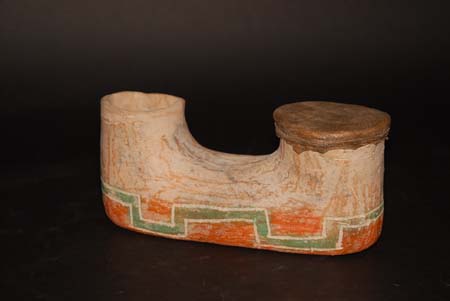
Water Drum
Yucatec Maya Culture
Mexico’s Yucatán Peninsula, northern Belize and northeastern Guatemala
Terracotta, pigment, hide
ca. 1970s
This water drum is played by hitting or scratching the hide with one hand while cupping (in various shapes) the other hand over the opening. Water amplifies sound and serves as a pitcher modulator.

Clay Hand Drum
Yucatec Maya Culture
Mexico’s Yucatán Peninsula, northern Belize and northeastern Guatemala
Terracotta, pigment, hide
ca. 1970s
A one-sided hand held drum, much like a tambourine. Decorative geometric designs throughout.
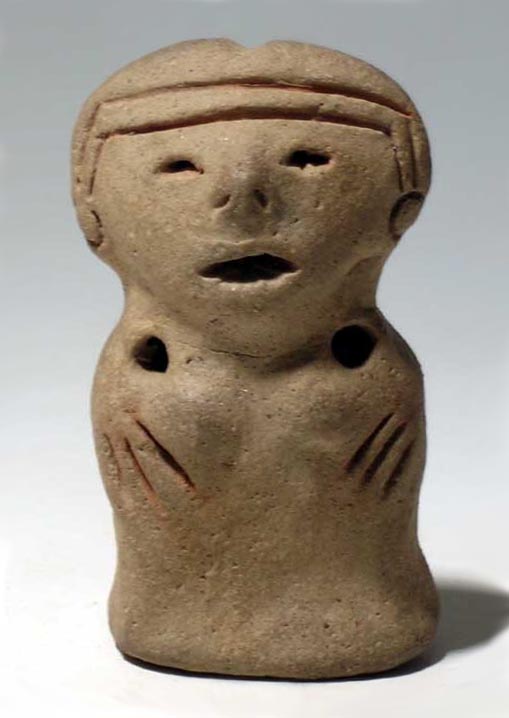
Figural Rattle
Maya Culture
Guatemala
Terracotta
ca. 1800s
Post-classic style Maya figural rattle with cinnabar remnants in incised grooves and mineral deposits. Figure has a rounded profile, with deep incised eyes and open mouth.

Chief Holding Rattle
Maya Culture
Jaina Island
Terracotta, pigment
ca. 1980s
Effigy pottery of a Mayan Chief in full regalia.

Udu Drum Hadgini
Developed by Frank Giorgini & Jamey Haddad
Latin Percussion
Garfield, New Jersey
Clay
ca. 1990s
Much of Latin American popular dance music became a blend of African and European traits and characteristics of various instruments were shared. The word “udu” means “vessel” and originated with the Igbo People of Nigeria.
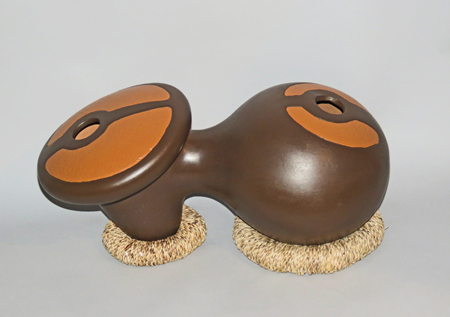
Udu Drum Udongo ii
Designed by Frank Giorgini
Latin Percussion
Garfield, New Jersey
Clay
ca. 1990s
The udu is originally from Nigeria, but spread out across the world. Adding water to the clay pot allows the player to change the pitch. This is a dual chambered drum with a large, straight air channel between the chambers.
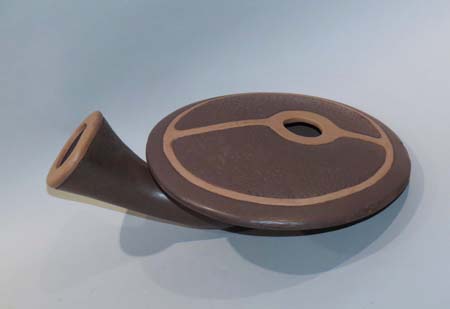
Udu Drum Tambuta
Designed by Frank Giorgini
Latin Percussion
Garfield, New Jersey
Clay
ca. 1990s
An udu drum that is flat, saucer shaped with an extended bell. Each of these udu drums offers different individual tonal values.
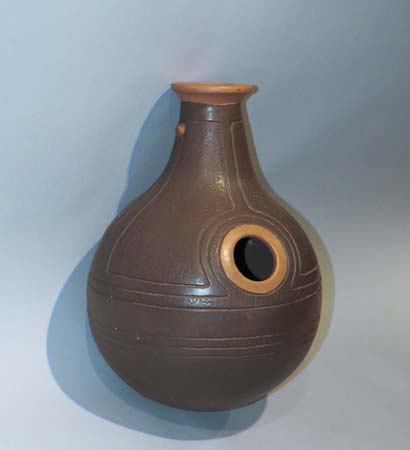
Udu Drum Clayton
Designed by Frank Giorgini
Latin Percussion
Garfield, New Jersey
Clay
ca. 1990s
This udu drum can be played by hitting any part of the drum with the palm of the hand or the finger tips. The textured surfaces provide additional tonal variations by creating rubbing sounds.
